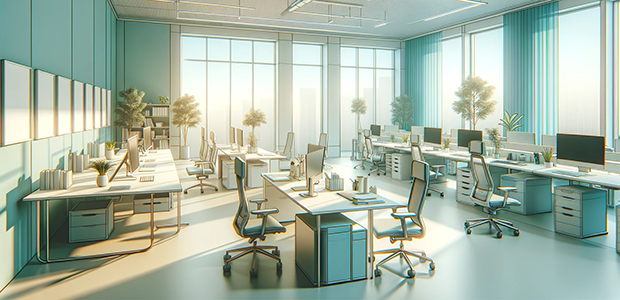
Maximise productivity: experts provide seven calm office design tips
Creating a calm office environment isn't just about aesthetics; it's a strategic move that reduces stress, supports mental health, and boosts overall employee satisfaction and productivity.
To help businesses craft office spaces where employees can work in a calm and relaxed environment, Studio Alliance's office design experts have shared seven practical tips. These tips aim to empower organisations to establish work environments that prioritise productivity, comfort, and the well-being of all employees.
Noise reduction: implement strategies to minimise excessive noise, which can be a significant source of stress. Use acoustic panels, rugs, and soft furnishings to absorb sound. Consider designating quiet zones or providing noise-cancelling headphones for employees who need focused, uninterrupted work time. Creating a tranquil soundscape with background music or white noise can also contribute to a calming atmosphere.
Personalisation and comfort: allow employees to personalise their workspaces within certain guidelines. Allowing personal touches, such as plants, artwork, or comfortable desk accessories, can help individuals feel more at ease and connected to their work environment. Comfortable and adjustable seating options, along with cosy breakout spaces, contribute to an overall sense of well-being.
Mindfulness spaces: designate specific areas within the office for mindfulness and relaxation. This can include meditation rooms, quiet corners with comfortable seating, or even dedicated spaces for stretching or yoga. Encouraging employees to take short breaks to relax and recharge can have a positive impact on their mental well-being.
Organisational clarity: maintain a clutter-free and organised workspace. Clutter can contribute to feelings of overwhelm and stress. Encourage employees to declutter their desks and provide ample storage solutions. Adopting minimalistic design principles for shared spaces can also create a sense of order and tranquillity.
Neutral and calming colour palette: choose a soothing colour palette with neutral tones and soft hues. Colours like blues, greens, and earthy tones can have a calming effect. Avoid overly bright or jarring colours that may contribute to visual stress. Consider incorporating these colours in wall paint, furniture, and decor elements.
Technology detox zones: create designated areas where employees can take a break from screens and technology. Furnish these zones with comfortable seating and encourage employees to disconnect momentarily, promoting mental relaxation, and reducing eye strain associated with prolonged screen time.
Natural lighting optimisation: ensure workspaces are optimised for natural light exposure. Position desks and common areas strategically to maximise access to sunlight, helping regulate circadian rhythms and positively impacting employee mood, alertness, and overall well-being.
“The trend away from open space solutions has been clearly recognisable in recent years. Employees who come to the office not only want the identity of the company and social interaction with colleagues but also the opportunity to focus on their work. This is often not possible working from home” Bjørn Polzin Head of Planning at apoprojekt (member of Studio Alliance).

